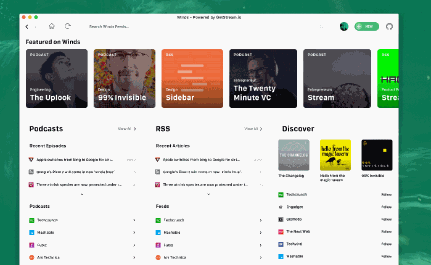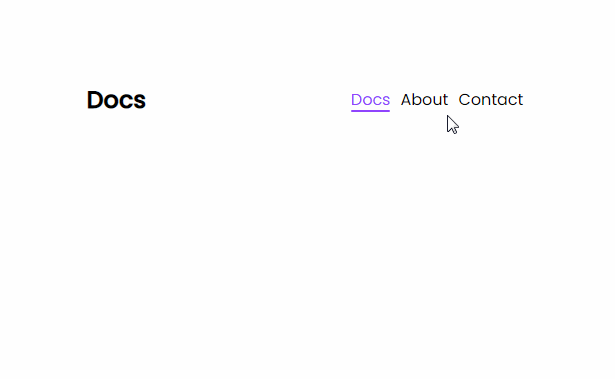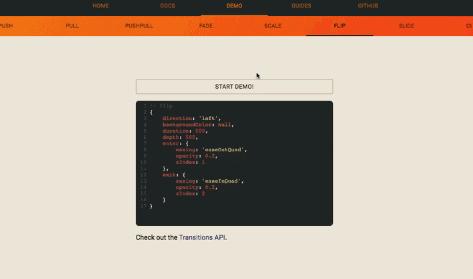next-page-transitions
Simple and customizable page transitions for Next.js apps.
What does this library do for me?
Simply put, it makes it easy to add page transitions to apps build with Next.js.
It may work with other frameworks, but it was designed around the new App
component and the way that Next.js handles pages. Specifically, it solves the
problem of making sure only one page component is mounted at a time and that the
next page isn't mounted until the previous one has completed its exit animation.
It also has built-in support for showing a loading indicator if your page
component has to load data before it can be shown.
Examples
If you prefer to learn by example, check out the examples directory for
some Next.js apps that demonstrate how this library can be used.
Getting started
First, install the package:
npm install --save next-page-transitions
Next, ensure that your app has a custom App component; if not,
follow the example on the Next.js
readme to create one. Then, in your App's render method, wrap the page
Component in a PageTransition component. You'll also have to define your
own CSS classes that achieve the transition animations that you want. To keep
this library simple and to account for the wide variety of ways that people
produce and consume CSS, it doesn't offer any built-in styles and has no
particular opinion about how the styles end up on your page. The example below
has a simple transition that fades pages in and out.
import App, { Container } from 'next/app'
import React from 'react'
import { PageTransition } from 'next-page-transitions'
export default class MyApp extends App {
static async getInitialProps({ Component, router, ctx }) {
let pageProps = {}
if (Component.getInitialProps) {
pageProps = await Component.getInitialProps(ctx)
}
return { pageProps }
}
render() {
const { Component, pageProps } = this.props
return (
<Container>
<PageTransition timeout={300} classNames="page-transition">
<Component {...pageProps} />
</PageTransition>
<style jsx global>{`
.page-transition-enter {
opacity: 0;
}
.page-transition-enter-active {
opacity: 1;
transition: opacity 300ms;
}
.page-transition-exit {
opacity: 1;
}
.page-transition-exit-active {
opacity: 0;
transition: opacity 300ms;
}
`}</style>
</Container>
)
}
}
When you move to a new page, the Component will change, and the
PageTransition component will detect that. Instead of immediately unmounting
the page, it will apply the page-transition-exit class to a wrapper around
the page to initialize the "exit" transition, and will then apply the
page-transition-exit-active class as well to begin the transition. This is
very similar to how the
react-transition-group
library does things things. After the previous page has been animated out,
the new page is mounted and a similar pair of .page-transition-enter and
page-transition-enter-active classes will be applied. This process repeats
every time a new page is navigated to.
Handling Context/Store changes that update props on the Component
If you happen to have an architecture that allows for changes to flow into
your page from the _app.js component, you may notice that transitions trigger
on the page when the props change. To remedy this, provide a key prop on your
Component. With Next.js there is a really great way to do this, using the router.
<PageTransition classNames="page-transition" timeout={300}>
<Component key={this.props.router.route} {...pageProps} />
</PageTransition>
Support for delayed enters
Suppose you have a page that needs to make a network request before it can
display its content. You could have the page itself render a loading spinner
until it's ready to go, but then you lose the beautiful page transition
animation you spent all that time perfecting. Luckily, this library makes it
easy to handle that case.
If you add a static property pageTransitionDelayEnter = true to your page
component, your page will be passed a special callback prop that you can use
to indicate that everything has finished loading. In the meantime, your page
will be mounted, but the enter transition won't be started yet, and a loading
indicator of your choice will be shown in its place. When you call the callback
prop, the loading spinner will be hidden, and your page will be animated into
place! By default, the callback is passed via the pageTransitionReadyToEnter
prop, but this can be specified by setting the loadingCallbackName prop on
your PageTransition component.
Note: make sure that your component returns null from its render() function
until it has finished loading its content and is ready to be animated in. Your
page will still be in the React component tree while it's loading!
"But my network requests are usually fast!", you'll say. "They usually take only
a few hundred milliseconds, and I don't want to flash a loading indicator on the
screen for such a short period of time!" This library can handle that case as
well. If you specify a loadingDelay prop, the loading indicator won't be
shown until that much time has elapsed. If your component is ready to enter
before then, the loading indicator will never be shown, keeping the UX clean
and snappy. However, if your component is taking a long time, the loading
indicator will be shown until your component is ready.
"That sounds kind of like the Placeholder concept from that React suspense
talk. The one in this YouTube video."
Yes, yes it does! That was the inspiration for this feature.
Here's an example component that simulates a network request with a timeout:
class About extends React.Component {
static pageTransitionDelayEnter = true
constructor(props) {
super(props)
this.state = { loaded: false }
}
componentDidMount() {
this.timeoutId = setTimeout(() => {
this.props.pageTransitionReadyToEnter()
this.setState({ loaded: true })
}, 2000)
}
componentWillUnmount() {
if (this.timeoutId) clearTimeout(this.timeoutId)
}
render() {
if (!this.state.loaded) return null
return <div>Hello, world!</div>
}
}
Assume for a moment that you have a Loader component that rendering a nice
spinning loading indicator. You'll have to tell the PageTransition
component that you want to use this component, and how long you want to wait
until showing the network indicator:
<PageTransition
timeout={300}
classNames="page-transition"
loadingComponent={<Loader />}
loadingDelay={500}
loadingTimeout={{
enter: 400,
exit: 0,
}}
loadingClassNames="loading-indicator"
>
<Component {...pageProps} />
</PageTransition>
You'll also have to add styles if you want the loading indicator to be animated
on/off the screen. If you want it to appear/disappear without any animation, you
can add loadingTimeout={0} and omit the loadingClassNames property.
Check out the delayed-enter app under the examples directory for a complete
example of what this looks like. The "About" page (pages/about.js) will wait
2 seconds before displaying its content, and in the meantime, the component at
components/Loader.js will be displayed. Play around with the various delays
to gain a deeper sense of how this component works.
PageTransition props
classNames: Specifies the class names that will be applied to the page
wrapper to drive the page transition animations. Analogous to theclassNames
prop of
react-transition-group'sCSSTranstition
component.
However, note that only the string form of that prop is supported at present.
Also, note that this library doesn't have a separate "appear" state; only
"enter" and "exit" classes are needed.timeout: Specifies timeouts for the page transition animations.
Analogous to thetimeoutprop of
react-transition-group'sCSSTranstition
component.loadingComponent: A React element to be shown whileloadingDelay: The duration to wait before showing the loading
indicator, in milliseconds. If a page finishes loading before this duration
has elapsed, the loading component will never be shown. Defaults to 500ms.loadingCallbackName: Specifies the name of the prop that your page will
receive to call when it's done loading. Defaults topageTransitionReadyToEnterloadingTimeout: Analogous to thetimeoutprop of
react-transition-group'sCSSTranstition
component. If this prop is set to0, the loading indicator won't be animated on/off
the screen.loadingClassNames: Specifies the class names that will be applied to the
loading component if one is specified. Analogous to theclassNamesprop of
react-transition-group'sCSSTranstition
component.monkeyPatchScrolling: By default, Next'sLinkcomponent will scroll to
the top of the page whenever it is clicked; this can have an undesirable
jumpy effect when a page is transitioning out. If this prop is set totrue
when the component is mounted, thenwindow.scrollTowill be monkey-patched
so that programmatic scrolling can be disabled while a page is transitioning
out. Defaults to false, since this potentially sketchy behavior should be
opt-in.





